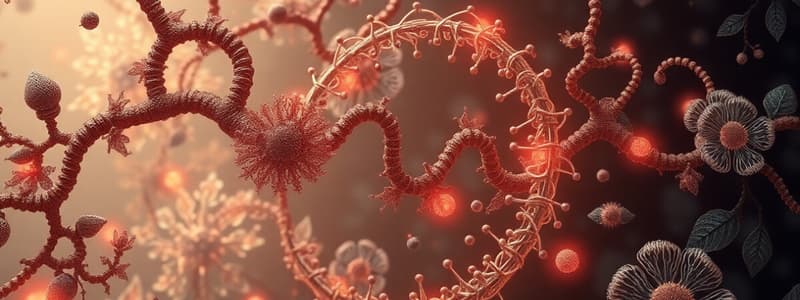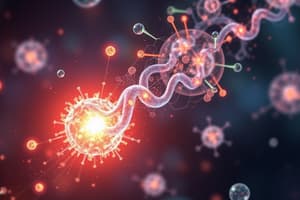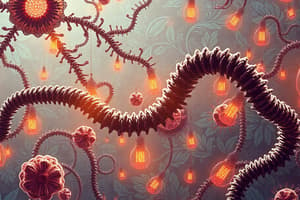Podcast
Questions and Answers
What is the role of endogenous ADP in cellular respiration?
What is the role of endogenous ADP in cellular respiration?
- Inhibits proton-motive force.
- Increases ATP formation.
- Depletes ATP levels.
- Controls the rate of respiration depending on its quantity within a cell. (correct)
What effect do uncouplers, such as 2,4-dinitrophenol (DNP), have on ATP synthesis?
What effect do uncouplers, such as 2,4-dinitrophenol (DNP), have on ATP synthesis?
- Facilitate electron transfer in the ETC.
- Enhance ATP production by increasing proton flow.
- Inhibit ATP synthesis by separating proton-motive force. (correct)
- Increase the production of glucose during respiration.
What is a characteristic of metabolic blocks in the electron transport chain (ETC)?
What is a characteristic of metabolic blocks in the electron transport chain (ETC)?
- They allow normal electron flow through the ETC.
- They enhance ATP generation.
- They can disrupt the proton gradient. (correct)
- They promote the function of ATP synthase.
What process do cells utilize to generate ATP in the absence of glucose?
What process do cells utilize to generate ATP in the absence of glucose?
In which type of cell is brown fat more commonly found, and what function does thermogenin serve?
In which type of cell is brown fat more commonly found, and what function does thermogenin serve?
What is the primary location where glycolysis occurs?
What is the primary location where glycolysis occurs?
Which statement correctly describes oxidative phosphorylation?
Which statement correctly describes oxidative phosphorylation?
During glycolysis, how many ATP are produced net per glucose molecule by substrate-level phosphorylation?
During glycolysis, how many ATP are produced net per glucose molecule by substrate-level phosphorylation?
What occurs during the Pasteur effect?
What occurs during the Pasteur effect?
What is the primary purpose of glycolysis in cellular respiration?
What is the primary purpose of glycolysis in cellular respiration?
What role do NAD+ and FAD play in cellular respiration?
What role do NAD+ and FAD play in cellular respiration?
Which of the following reactions occurs in the mitochondrial matrix?
Which of the following reactions occurs in the mitochondrial matrix?
Which of the following correctly describes fermentation?
Which of the following correctly describes fermentation?
During which phase of cellular respiration is the most ATP produced?
During which phase of cellular respiration is the most ATP produced?
What happens to NADH when there is no oxygen available?
What happens to NADH when there is no oxygen available?
How many electrons are carried by one molecule of reduced NADH?
How many electrons are carried by one molecule of reduced NADH?
What is the primary function of the TCA cycle in cellular respiration?
What is the primary function of the TCA cycle in cellular respiration?
Which molecule acts as the final electron acceptor in the electron transport chain?
Which molecule acts as the final electron acceptor in the electron transport chain?
How do uncouplers like 2,4-dinitrophenol (DNP) affect mitochondrial function?
How do uncouplers like 2,4-dinitrophenol (DNP) affect mitochondrial function?
In an obligate aerobe, what is essential for survival?
In an obligate aerobe, what is essential for survival?
What is produced by the electron transport chain aside from ATP?
What is produced by the electron transport chain aside from ATP?
What is the main consequence of low levels of ADP in cellular respiration?
What is the main consequence of low levels of ADP in cellular respiration?
What is oxidative phosphorylation mainly responsible for?
What is oxidative phosphorylation mainly responsible for?
What is the role of thermogenin in brown fat tissue?
What is the role of thermogenin in brown fat tissue?
Which statement accurately describes the action of metabolic blocks on the electron transport chain?
Which statement accurately describes the action of metabolic blocks on the electron transport chain?
What is the preferred fuel for most cells during respiration?
What is the preferred fuel for most cells during respiration?
Which of the following is true regarding exergonic reactions?
Which of the following is true regarding exergonic reactions?
Which statement accurately describes endergonic reactions?
Which statement accurately describes endergonic reactions?
What is the significance of ATP hydrolysis in cellular processes?
What is the significance of ATP hydrolysis in cellular processes?
What is the main purpose of aerobic cellular respiration?
What is the main purpose of aerobic cellular respiration?
Which statements describe mitochondria accurately?
Which statements describe mitochondria accurately?
Which type of organism can undergo aerobic respiration?
Which type of organism can undergo aerobic respiration?
What describes the process of endosymbiosis in relation to mitochondria?
What describes the process of endosymbiosis in relation to mitochondria?
Which reaction represents the overall process of aerobic cellular respiration?
Which reaction represents the overall process of aerobic cellular respiration?
How many ATP are produced by substrate-level phosphorylation at the end of glycolysis per glucose molecule?
How many ATP are produced by substrate-level phosphorylation at the end of glycolysis per glucose molecule?
What is the main function of NAD+ and FAD in cellular respiration?
What is the main function of NAD+ and FAD in cellular respiration?
What is the primary location of the TCA cycle?
What is the primary location of the TCA cycle?
What occurs to glucose consumption during the Pasteur effect?
What occurs to glucose consumption during the Pasteur effect?
Which process generates the most ATP during cellular respiration?
Which process generates the most ATP during cellular respiration?
What happens to NADH during fermentation when oxygen is absent?
What happens to NADH during fermentation when oxygen is absent?
Which statement correctly describes the energy phases during glycolysis?
Which statement correctly describes the energy phases during glycolysis?
In what circumstance does a cell primarily rely on glycolysis for ATP production?
In what circumstance does a cell primarily rely on glycolysis for ATP production?
Flashcards
Metabolism
Metabolism
The sum of all chemical reactions in the body.
Exergonic Reaction
Exergonic Reaction
Releases energy, negative ΔG, and spontaneous.
Endergonic Reaction
Endergonic Reaction
Requires energy, positive ΔG, and non-spontaneous.
Energy Coupling
Energy Coupling
Signup and view all the flashcards
ATP Hydrolysis
ATP Hydrolysis
Signup and view all the flashcards
ATP
ATP
Signup and view all the flashcards
Cellular Respiration
Cellular Respiration
Signup and view all the flashcards
Aerobic Cellular Respiration
Aerobic Cellular Respiration
Signup and view all the flashcards
Mitochondria
Mitochondria
Signup and view all the flashcards
Glycolysis
Glycolysis
Signup and view all the flashcards
Oxidation of Pyruvate
Oxidation of Pyruvate
Signup and view all the flashcards
TCA Cycle
TCA Cycle
Signup and view all the flashcards
Chemiosmosis
Chemiosmosis
Signup and view all the flashcards
Substrate-level Phosphorylation
Substrate-level Phosphorylation
Signup and view all the flashcards
Oxidative Phosphorylation
Oxidative Phosphorylation
Signup and view all the flashcards
Electron Carriers
Electron Carriers
Signup and view all the flashcards
NAD+
NAD+
Signup and view all the flashcards
NADH
NADH
Signup and view all the flashcards
Glycolysis Outcomes
Glycolysis Outcomes
Signup and view all the flashcards
Anaerobic Conditions
Anaerobic Conditions
Signup and view all the flashcards
Fermentation
Fermentation
Signup and view all the flashcards
ADP levels
ADP levels
Signup and view all the flashcards
Uncouplers
Uncouplers
Signup and view all the flashcards
Metabolic Blocks
Metabolic Blocks
Signup and view all the flashcards
Study Notes
Metabolism
- Metabolism is the sum of all chemical reactions in the body.
Exergonic and Endergonic Reactions
- Exergonic reactions release energy, have a negative ΔG, and are spontaneous. They are catabolic reactions that break down molecules.
- Endergonic reactions require energy, have a positive ΔG, and are non-spontaneous. They are anabolic reactions that build up molecules.
Energy Coupling
- Endergonic reactions are coupled to exergonic reactions to drive them forward.
ATP Hydrolysis
- ATP is the major energy currency of cells.
- ATP hydrolysis is an exergonic reaction that releases energy: ATP → ADP + Pi, ΔG = -7.3 kcal/mol.
- Cells regenerate ATP from ADP + Pi through cellular respiration.
Cellular Respiration
- Cellular respiration is the process of regenerating ATP from ADP + Pi.
- Aerobic cellular respiration requires oxygen and involves the complete oxidation of glucose to CO2 and the reduction of oxygen to H2O.
- The chemical equation for aerobic cellular respiration is: C6H12O6 + 6O2 → 6H2O + 6CO2.
- Cellular respiration requires both the cytosol and mitochondria.
Mitochondria
- Mitochondria are organelles that are responsible for cellular respiration.
- Mitochondria originated from free-living bacteria through endosymbiosis.
Stages of Aerobic Cellular Respiration
- There are four stages of aerobic cellular respiration:
- Glycolysis: Occurs in the cytosol and breaks down glucose into pyruvate.
- Oxidation of Pyruvate: Occurs in the mitochondrial matrix and converts pyruvate into acetyl-CoA.
- TCA Cycle (Krebs Cycle): Occurs in the mitochondrial matrix and oxidizes acetyl-CoA to CO2, generating electron carriers.
- Chemiosmosis, Oxidative Phosphorylation, and Electron Transport Chain: Occurs in the mitochondrial matrix, intermembrane space, and inner mitochondrial membrane, and uses electron carriers to generate ATP.
Comparing Substrate-Level and Oxidative Phosphorylation
- Substrate-level phosphorylation directly transfers a phosphate group from a substrate to ADP, generating ATP.
- Oxidative phosphorylation uses the electron transport chain and oxygen to generate ATP. It is the main source of ATP during aerobic respiration.
Electron Carriers
- NAD+ (Nicotinamide Adenine Dinucleotide) and FAD (Flavin Adenine Dinucleotide) are electron carriers involved in cellular respiration.
- NAD+ and FAD are oxidized forms that do not carry electrons.
- NADH and FADH2 are reduced forms that carry two electrons each.
Glycolysis
- Glycolysis has two phases:
- Energy-requiring phase: Requires 2 ATP per glucose.
- Energy-yielding phase: Produces 4 ATP per glucose.
Outputs of Glycolysis
- Per glucose molecule, glycolysis produces:
- 2 NADH (4 electrons)
- 2 pyruvate
- 4 ATP (2 net) by substrate-level phosphorylation.
Anaerobic Conditions
- If there is no oxygen, cells can only regenerate ATP by glycolysis.
- This leads to an increase in glucose uptake (Pasteur effect).
- Fermentation is used to oxidize NADH to NAD+ and regenerate ATP in anaerobic conditions.
ADP Levels and Respiration
- Low levels of ADP decrease the rate of respiration.
- High levels of ADP increase the rate of respiration.
Uncouplers
- Uncouplers inhibit ATP synthesis by separating the proton-motive force across the inner mitochondrial membrane from ATP synthase.
- Examples include chemical uncouplers (DNP) and natural substances like thermogenin.
Metabolic Blocks
- Metabolic blocks prevent electron flow through the electron transport chain, disrupting the proton gradient and reducing ATP generation.
- Examples include cyanide, rotenone, malonate, antimycin-a, and oligomycin.
Alternative Fuels
- Cells can utilize other organic compounds to regenerate ATP in the absence of glucose.
- β-oxidation: Uses fatty acids for mitochondrial respiration.
- Gluconeogenesis: Produces glucose from sources other than glycogen.
- Different cell types have different preferences for fuel sources. For example, neurons, erythrocytes, and kidney medullar cells primarily use glucose, while cardiomyocytes preferentially use fatty acids.
Metabolism Overview
- Metabolism: Summation of all chemical reactions within an organism
- Complex human metabolic map
- Reactions can be exergonic or endergonic
- Exergonic reactions release energy (downhill) and have a negative ΔG
- Endergonic reactions require energy (uphill) and have a positive ΔG
- Catabolic reactions are exergonic and break down molecules
- Anabolic reactions are endergonic and build up molecules
Energy Coupling
- Endergonic reactions are coupled to exergonic reactions
- Theoretically, any endergonic reaction can be coupled to any exergonic reaction
- ATP hydrolysis is the most common exergonic coupling reaction
ATP Hydrolysis
- ATP: Primary energy currency of cells
- ATP hydrolysis: ATP ADP + Pi; releases -7.3 kcal/mol of energy
- Cells regenerate ATP from ADP + Pi through cellular respiration
- Average human regenerates about 100 moles of ATP per day (~6x1020 ATP/second)
Cellular Respiration
- Chemical equation: C6H12O6 + 6O2 6H2O + 6CO2
- Glucose is oxidized to CO2 and oxygen is reduced to H2O
- Requires both cytosol and mitochondria in eukaryotic cells
Mitochondrion
- Origin: Endosymbiotic process: Mitochondria evolved from free-living bacteria that were engulfed by an early eukaryotic cell
- Some mitochondrial genes migrated to the nucleus.
Aerobic Cellular Respiration
- Obligate aerobes, facultative aerobes, and facultative anaerobes undergo aerobic respiration
- Four spatially separated reactions:
- Glycolysis: Cytosol
- Oxidation of pyruvate: Mitochondrial matrix
- TCA cycle: Mitochondrial matrix
- Chemiosmosis, Oxidative phosphorylation, and electron transport chain: Mitochondrial matrix, intermembrane space, and inner mitochondrial membrane
Comparing Substrate-Level & Oxidative Phosphorylation
- Substrate-level phosphorylation: Directly transfers a phosphate group from a substrate molecule to ADP
- Oxidative phosphorylation: Utilizes electron transport chain and oxygen to generate ATP; most ATP produced during aerobic respiration
Electron Carriers
- NAD+ (Nicotinamide Adenine Dinucleotide) and FAD (Flavin Adenine Dinucleotide)
- NAD+ and FAD are oxidized forms without electrons; reduced forms carry 2 electrons each
- NAD+ NADH + H+
- FAD FADH2
Glycolysis
- Two phases:
- Energy-requiring phase: Requires 2 ATP per glucose
- Energy-yielding phase: Produces 4 ATP per glucose
- By the end of glycolysis:
- 2 NADH (4 e-)
- 2 pyruvate
- 4 ATP (2 net) produced through substrate-level phosphorylation
Without Oxygen
- Cells only regenerate ATP through glycolysis
- Increased glucose uptake (Pasteur effect): Shift from slow aerobic to rapid anaerobic glucose consumption
- Fermentation: NADH is oxidized to NAD+ to continue glucose breakdown
- Lactic acid accumulates in muscles
ADP Levels & Respiratory Rate
- Endogenous ADP is depleted by ATP formation
- Low ADP levels decrease respiratory rate; high ADP levels increase respiratory rate
Uncouplers
- Separate proton-motive force from ATP synthesis, inhibiting ATP generation
- Chemical uncouplers (e.g., 2,4-dinitrophenol) and natural substances (e.g., thermogenin)
Metabolic Blocks
- Prevent electron flow through the ETC
- Disrupt proton gradient, reducing ATP production
- Examples: Cyanide, rotenone, malonate, antimycin-A, oligomycin
Alternative Fuels
- Most cells prefer glucose for respiration
- Cells can metabolize other organic compounds in absence of glucose:
- β-oxidation: Use of fatty acids for mitochondrial respiration
- Gluconeogenesis: Production of glucose from sources other than glycogen
- Some cells (neurons, erythrocytes, kidney medulla cells) use only glucose, while others may preferentially use fatty acids (e.g., cardiomyocytes)
2,4-Dinitrophenol (DNP)
- Chemical uncoupler that dissipates proton gradient across the inner mitochondrial membrane, reducing ATP synthesis and increasing heat generation
Thermogenin
- Proton carrier protein found in brown fat mitochondria
- Transports protons across mitochondrial membrane without ATP synthase, generating heat instead of ATP
- More common in children than adults
Studying That Suits You
Use AI to generate personalized quizzes and flashcards to suit your learning preferences.




